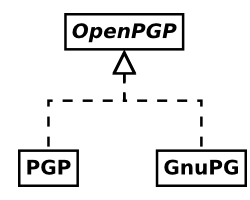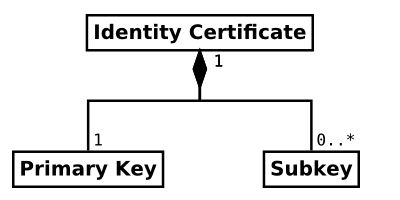Articles tagged with Confusion
-
-
Lately I spent a lot of time exploring the details of GnuPG and the underlying OpenPGP standard. I found that there are many outdated guides and tutorials which still find their way into the hands of newcomers. There seems to be a cloud of confusion around the topic, which leads to many misinformed users, but also to the idea that OpenPGP is hard to understand.
This article is my attempt to fight some of this confusion and misinformation.
-
Naming confusion
A lot of people seem to have problems separating the different terms.
- OpenPGP is a standard for managing cryptographic identities and related keys mostly described by RFC 4880. It also provides a framework for issuing and verification of digital signatures and for encrypting and decrypting of data using the aforementioned identities.
- PGP, meaning Pretty Good Privacy, was the first implementation of the system now standardized as OpenPGP. It is proprietary software currently owned an being developed by Symantec.
- GnuPG, the GNU Privacy Guard, is probably the most wide-spread free software implementation of the OpenPGP standard. Some lazy people also call it GPG because it’s executable is called
gpg. This confuses people even more.

-
“OpenPGP is just for e-mail”
It is true that OpenPGP was created to allow secure e-mail communication. But OpenPGP can do far more than that.
One major field of usage for OpenPGP is the secure distribution of software releases. Almost all of the big Linux distributions and lots of other software projects rely on GnuPG to verify that the downloaded packages are indeed identical to those made by the original authors.
OpenPGP can encrypt and digitally sign arbitrary files. Also, by using so called ASCII-armored messages, OpenPGP can be used to send encrypted and signed messages through every system that is able to relay multi-line text messages.
In addition, OpenPGP identity certificates can be used to authenticate to SSH servers. They can also be used to verify the identities of remote servers through Monkeysphere.
All in all, OpenPGP is a fully-fledged competitor to the X.509 certificate system used in SSL/TLS and S/MIME. Personally I think OpenPGP actually outperforms X.509 in any regard.
-
Certificates and keys
Far too many things in OpenPGP are called keys by many people. In OpenPGP, an identity is formed by one or more asymmetric crypto keys. Those keys are linked together by digital signatures. Also, there is a whole lot of other useful data contained within this structure.
A lot of times, I have seen that describing this whole bunch of different pieces of data “a key” just makes it harder for people to understand the system. Calling it an identity certificate describes it far better and allows people distinguish between it and the actual crypto keys within.

-
Fingerprints and other key identifiers
Each key in OpenPGP (of the current version 4) can be securely identified by a sequence of 160 bits, called a fingerprint. This sequence is usually represented by 40 hexadecimal characters to be easier to read and compare. OpenPGP identity certificates are identified by the fingerprints of their primary keys.
The fingerprint is designed in a way, so that it is currently considered infeasible to deliberately generate another certificate which has the same fingerprint. Behind the scenes this is achieved by using the cryptographic hash function SHA-1.
Versions of GnuPG prior to version 2.1 did not display the full fingerprint by default. Instead they displayed a so called key ID. Key IDs are excerpts of the end of fingerprint sequence. The short variant is the 8 hexadecimal characters, the long variant is 16 hexadecimal characters long.
Fingerprint: 0123456789ABCDEF0123456789ABCDEF01234567 Long key ID: 89ABCDEF01234567 Short key ID: 01234567
Even today, these key IDs are displayed prominently within GnuPG’s output and lots of OpenPGP related GUI programs and websites display them. They all fail to warn the user that neither the short, nor the long key ID can be used to securely identify a certificate, because they have been shown to be easily spoofable. Please don’t rely on these, or even better, avoid them completely and use full fingerprints instead.
-
Secure exchange of identity certificates
Probably the biggest obstacle of establishing secure communication through cryptography is making sure that both parties own a copy of each other’s public asymmetric key. If a malicious third party is able to provide both communication partners with fake keys, the whole cryptography can be circumvented by performing a MITM attack.
In OpenPGP, communication partners need to exchange copies of each others identity certificates prior to usage. To deny possible attackers, this needs to be done through a secure channel. Sadly, secure channels are very rare. One way could be to burn the certificates to CDs and exchange these at a personal meeting.
The certificates could also be uploaded to a file server and downloaded by both communication partners, provided that they verify the fingerprints of the certificates afterwards. The fingerprints still needs to be exchanged through a secure channel.
-
Key servers
Key servers are specialized file servers that allow anyone to publish OpenPGP certificates. Some key server networks continuously synchronize their contents, so you only need to upload your certificates to one of the network participants. Most key servers don’t allow to delete any content that has ever been uploaded to them, so make sure not to publish things you’d later regret.
Be aware that usually, key servers are not certificate authorities. Everyone can upload any certificates they like and usually, no verification is performed. There is no reason to ever assume the certificates received from a generic key server to be anyhow authentic. Just like with any other insecure channel, you have to compare the certificate’s fingerprints with a copy received through a secure channel.
Instead, key servers are a great way to receive updated information about known certificates. For example, if an OpenPGP certificate expires, it can be renewed by its owner and the update can then be published to the key servers again. Another important scenario would be a identity certificate that has been compromised. The owner can then publish a revokation certificate to the key servers to inform other people that the certificate is no longer safe to be used.
So key servers are less of an address book, rather than a mechanism for certificate updates. OpenPGP users are well advised to update certificates before each usage or on a regular interval.
-
